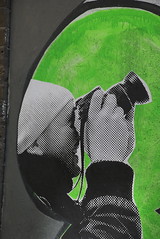This coming Sunday 1st February will be the first day of Wikipedia Loves Art – which will run until the end of the month. The event will see cultural heritage institutions around the world open up their doors for the public to take pictures of items in their collections that have passed into the public domain. All photographs will be made available under an open license (most likely either CC-BY or CC-BY-SA) – and hence will be free to be added to relevant Wikipedia articles, to be used as illustrations, to be cut up with other images, to be used in films and animations, and so on!
Participating institutions include:
- Brooklyn Museum
- Art Gallery of New South Wales
- Carnegie Museum of Art
- The Film Society of Lincoln Center
- Honolulu Academy of Arts
- Houston Museum of Natural Science
- The Hunter Museum of American Art
- Indianapolis Museum of Art
- The Jewish Museum
- Los Angeles County Museum of Art
- The Metropolitan Museum of Art
- Museum of Modern Art
- New-York Historical Society
- Smithsonian American Art Museum
- Taft Museum of Art
- V&A (we’ll come along to this on Sunday!)
Many of the participating institutions are running competitions to see who (or which team) can snap as many items from a list as possible. Prizes include books, exhibition catalogues, tickets, memberships, subscriptions, t-shirts, MP3 players, and private after-dark tours. All images will be added to the Flickr group.
Its great to see public cultural heritage collections opening up their collections! We look forward to the photos being re-used in interesting ways. (For other collections of open images, see the images tag on CKAN.)
Dr. Jonathan Gray is Lecturer in Critical Infrastructure Studies at the Department of Digital Humanities, King’s College London, where he is currently writing a book on data worlds. He is also Cofounder of the Public Data Lab; and Research Associate at the Digital Methods Initiative (University of Amsterdam) and the médialab (Sciences Po, Paris). More about his work can be found at jonathangray.org and he tweets at @jwyg.










I really love this idea! We really need to rid ourselves of the collection services like ARTstor (http://www.artstor.org) who incorrectly assign copyright on public domain works.
Speaking of which.
As per the Bridgeman Art Library v. Corel Corp. case (http://en.wikipedia.org/wiki/BridgemanArtLibraryv.Corel_Corp.) any photograph which faithfully represents a public domain work (and does not add any new creative element) does not create a new copyrightable work. In other words: if you take a photograph of a public domain painting your photograph is also public domain. Thus, assigning a CC:BY or BY-SA to the photos on flickr is actually creating MORE limitations than what should be there.
This isn’t necessarily the case for photographs of 3d objects (like statues) but it is for 2d paintings (or for scans of public domain books/text).
Lets not incorrectly assign copyright (CC:BY or BY-SA) to works that are really in the public domain.
Who do well tell at Wikimedia that the instructions for assigning a license in Flickr are wrong?
Unfortunately the situation is not quite this simple. Bridgeman vs. Corel is a US decision and the exact legal situation in other jurisdictions is at best uncertain.
For example, in the UK, it could be argued that Graves case still stands and that hence there is copyright in photograph of a public domain work (there is also the much more recent case of Sawkins vs. Hyperion). More discussion on this can be found in this thread and the associated faq.
Silkroad Online (silk road gold) is a fantasy MMORPG set in the 7th century AD, along the Silk Road between China and Europe. The game requires no periodic subscription fee, but players can purchase premium items to customize or accelerate gameplay.
Silkroad Online is noted for silk road gold its “Triangular Conflict System” in which characters can select from the three jobs of trader, hunter, and thief to engage each other in player versus player combat. Thieves attack traders who are protected by hunters. Hunters kill thieves getting experience to level up to a higher level of hunter. Traders silk road gold complete trade runs to get experience to level up to a higher level of trader, and thieves kill traders and hunters to level up. Thieves can also steal goods dropped by traders to take to the thieves’ den to exchange for gold and thief experience.